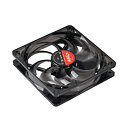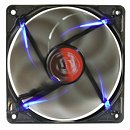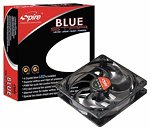Wednesday, September 8th 2010
Spire Introduces BlueStar LED Series Case Fans
Spire Corp introduced today their new line of BlueStar DC Fan LED Series. The BlueStar LED fans are high quality, LED colored and silent cooling fans for the PC gamer and PC enthusiast. Based on the original BlueStar fan blade design these new LED series are destined to be a big hit. Top of the line components and features are applied to build these powerful LED fans.
Included is a PWM auto fan speed control and for the ones who like to keep control in their own hands we have also included PCI manual fan speed control unit. To make the BlueStar fan series extra silent we have included 4 rubber anti-vibe mounts to install the fan and stop any fan vibration. Trust the brand with the industry leading experience and 3-year warranty, Spire.Main features:
Included is a PWM auto fan speed control and for the ones who like to keep control in their own hands we have also included PCI manual fan speed control unit. To make the BlueStar fan series extra silent we have included 4 rubber anti-vibe mounts to install the fan and stop any fan vibration. Trust the brand with the industry leading experience and 3-year warranty, Spire.Main features:
- Special fan blade shape and spokes design, ultra silent operation
- 4 Crystal blue LED's installed
- Superior airflow and High air pressure
- PWM fan auto fan control included
- PCI slot manual fan speed control included
- Sleeved wires for better airflow, and neat appearance
- 3pin + 4 pin PWM connectors
- UV-Reactant, great addition to any PC system



17 Comments on Spire Introduces BlueStar LED Series Case Fans
Air Flow 99.6CFM at 2,4000RPM
Sounds good to me. Might have to check one out. It does appear that they use sleeve bearings though :(
In general, the bearings are almost fully closed so dust isn't the problem as much as dry bearings. You have to submerge the entire bearing into oil and move it around violently to force oil to go inside through holes in the bearing housing. Take them out, rotate them a bit and repeat the process few times. Then you have to clean excessive oil from the housing and especially the part where the rotor goes through to prevent "sleeve bearing" effect inside the ball bearing as they are not attached together in a fixed way but the rotor still moves freely inside even if you block the ball bearing rotation. After doing that it's recommended to run such repaired fan for few minutes on lower RPM's (800-1000RPM) to let oil evenly spread inside. Much longer process than for sleeve bearings but from my experience it fixed a 7 years old stock AMD fan nearly perfectly from a noisy bastard to a silent fan again. At a cost of some oil. Not bad eh :) Haven't fixed any rifle bearing or fluid dynamic bearings yet...
I will find a way to try this myself, since I have quite a few fans in a closet that could use some maintenance.
Thanks a gazillion! I would put this exact post somewhere as a sticky, if I wuz mod... :ohwell:
@nvidiaintelftw
It all depends. I've seen dead silent sleeve bearing fans and ball bearing fans that were making awful grinding noise (new of course, not used). I've also had one Xigmatek fan with rifle bearings that was grinding like a mill.
But i've also had dead silent ball bearings and noisy sleeves. It's all down to design and overall quality. But as i said, sleeve bearings are the easiest to maintain. There is just one important thing about almost all types of bearings. You can use them for 10 years easily if you maintain them before they go noisy (lets say every 2 years). If you leave sleeve bearing chamber dry for too long you'll wear the rotor space and it won't run as smooth anymore even if you fix it later. It will be light years better but not perfect. Similar problem is with ball bearings. The balls will wear out if they run dry inside the bearing rings. The problem is that most ppl just run them forever. I've got several systems that were ridiculously noisy, but that did not bother their users.
But they were all surprised how silent systems were when they got them back from me.
Are you going to fix EVERY little consumer good that breaks on you and is easily replaced?
I dig the whole "Im not lazy or wasteful" attitude, but when are you gonna spend time with your gf/wife/kids/friends/doing something that makes more money or makes you happier?
I mean, honestly... if you have time to be fixing $10 fans for the sake of frugality, you have some serious time on your hands.
I dont see how that's not the same as throwing away a broken part and replacing it with a good part.